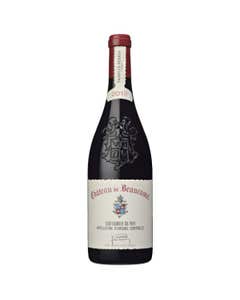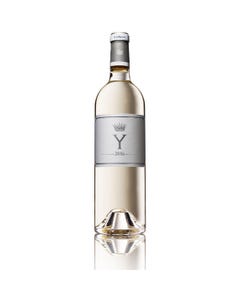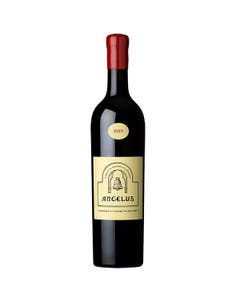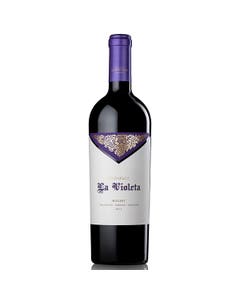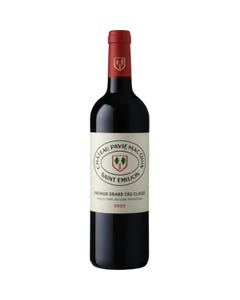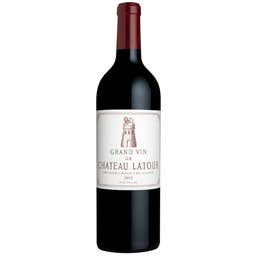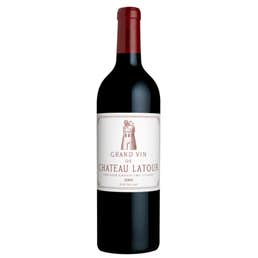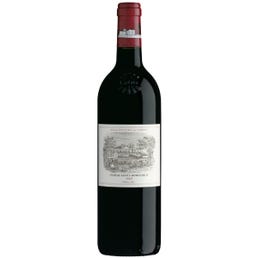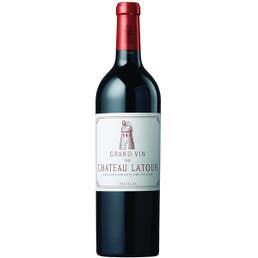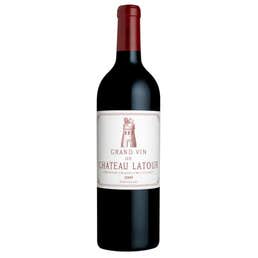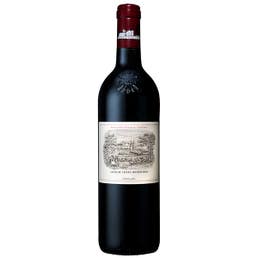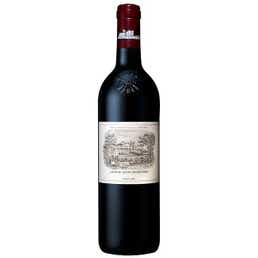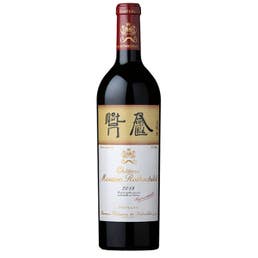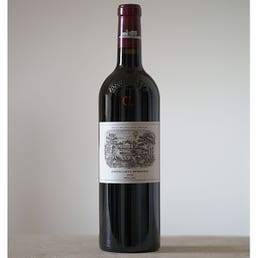Château Latour 2010
• Domaine: Château Latour
• Appellation: Pauillac
• Classification: First Growth, 1èr Grand Cru Classé
• Origin: Left Bank, Bordeaux, France
"The 2010 Latour can be summed up in two words: the King." - Neal Martin
At Château Latour, Cabernet Sauvignon is king. The estate boasts the most plantings of this regal varietal out of all the First Growths at about 10,000 plants per hectare – that’s over 80% of its vineyard! The wines of Château Latour possess everything a Cabernet-lover dreams about. Raw, unbridled power, energy, stunning fruit, and of course – ageability. Château Latour’s Grand Vin is one of the most age-worthy wines on the market, with the ability to lay down for decades.
In fact, Latour wines are so robust, that in 2012 Château Latour made the radical decision to eliminate Futures and only release their wines when they were ready to drink. It’s decisions like these – and many others – that put Château Latour in a league of its own. The visionaries at this property do not rest on their laurels by any means. Instead, they focus tirelessly on making innovative choices in their relentless pursuit of a perfect bottle, vintage after vintage.
Their instincts are often spot on- Château Latour is one of the most consistent First Growths on the market, producing knockout vintages year after year.
References to Château Latour date as far back to the 1300s, where its fortress served as a garrison during the 100 Year’s War. The Château really became known for its wine legacy when Marquis de Ségur – whom Louis XV affectionately referred to as, “the Wine Prince,”– snapped up the property as an addition to his collection of legendary châteaux. It seemed Marquis de Ségur had the magic touch, considering he owned the second-to-none Château Lafite Rothschild, Château Mouton Rothschild and Château Calon Ségur as well. During Marquis de Ségur’s ownership, the Château experienced a golden age and rose to prominence, earning its First Growth title during the 1855 Classification.
Château Latour has often stood at the forefront of vineyard management with cutting-edge practices. In 1965, they were one of the first châteaux to introduce stainless steel vats to the fermentation process. In 2008, they reassessed their vineyard management processes and decided to implement horses to plough the soil. Château Latour is one of the leading châteaux in terms of organic winemaking and obtained their organic certification from Ecocert in 2015. For some of the choicest parcels, the château uses Biodynamic philosophies and curates each vintage based on the weather conditions and lunar calendar. There is no end to the amount of energy, resources, and time the winemaking team at Château Latour will put into ensuring the best harvest is brought to bottle.
The wines of Château Latour are considered standouts in unremarkable years and in great years, they are considered legendary.
Ex-chateau release - Each bottle is marked: "RELEASE FROM CHATEAU LATOUR IN 2022"
Tasting Notes
"Spiced damson clear from the first moment, stroked satin in texture, loading up on cassis and bilberry fruits. The smoky, spicy side comes out after 15 to 20 minutes in the glass, along with smoked earth and turmeric. Huge amounts of crayon and pencil lead follow, this has less floral nuance than comparable vintages such as Latour 2016, which comes after full conversion to organic and biodynamic farming. What you get instead is utterly classic old school Latour from top to bottom, every inch powerful, muscular, stately. 2010 was a hydric stress year, with very little rain, in comparison to 2009 where the stress came from heat, and it is developing exactly as promised, which means slowly but surely, with the tannic architecture still brooding at 12 years old. At the very beginning of its drinking window, and on this showing just a nudge below the 2009 Latour, which I tasted in the same week. 36% of overall production." - Jane Anson, Inside Bordeaux (7/2/2022) Ratings: 98, Drink: 2024-2045
"The 2010 Latour can be summed up in two words: “The king.” It convincingly asserts its superiority over other 2010s, including First Growths, in terms of its aromatic complexity, precision, balance, intensity, complexity and persistence. Simply a faultless Latour that ranks among its greatest achievements. Tasted from an ex-château bottle at the BI Wines & Spirits 10-Year On tasting." - Neal Martin, vinous (4/2020), Ratings: 100, Drink: 2028-2070
"The 2010 Latour is deep garnet in color, and—WOW—it erupts from the glass with powerful crème de cassis, Black Forest cake and blackberry pie scents plus intense sparks of dried roses, cigar boxes, fragrant earth and smoked meats with aniseed and crushed rocks wafts. Full-bodied, concentrated and oh-so-decadent in the mouth, it has a firm, grainy texture and lovely freshness carrying the rich, opulent fruit to an epically long finish. It is incredibly tempting to drink now, but I suspect this hedonic experience isn't a scratch on the mind-blowing, otherworldly secrets this time capsule will have to reveal given another 7-10 years in bottle and continuing over the following fifty years++." - Lisa Perrotti-Brown, Robert Parker's Wine Advocate (3/5/2020), Ratings: 100, Drink: 2024-2080
"One of the perfect wines of the vintage, Frederic Engerer challenged me when I tasted the 2010 Latour at the estate, asking, “If you rate the 2009 one hundred, then how can this not be higher?” Well, the scoring system stops at 100, (and has for 34 years,) and will continue for as long as I continue to write about wine. Nevertheless, this blend of 90.5% Cabernet Sauvignon, 9.5% Merlot, and .5% Petit Verdot hit 14.4% natural alcohol and represents a tiny 36% of their entire production. The pH is about 3.6, which is normal compared to the 3.8 pH of the 2009, that wine being slightly lower in alcohol, hence the combination that makes it more flamboyant and accessible. The 2010 is a liquid skyscraper in the mouth, building layers upon layers of extravagant, if not over-the-top richness with its hints of subtle charcoal, truffle, blackberry, cassis, espresso and notes of toast and graphite. Full-bodied, with wonderfully sweet tannin, it is a mind-boggling, prodigious achievement that should hit its prime in about 15 years, and last for 50 to 100.
There is no denying the outrage and recriminations over the decision by the Pinault family and their administrator, Frederic Engerer, to pull Latour off the futures market next year. However, you can still buy these 2010s, although the first two wines are not likely to be released until they have more maturity, which makes sense from my perspective. Perhaps Latour may have offended a few loyal customers who were buying wines as futures, but they are trying to curtail all the interim speculation that occurs with great vintages of their wines (although only God knows what a great vintage of future Latour will bring at seven or eight years after the harvest). As a set of wines, the 2010s may be the Pinaults’ and Engerer’s greatest achievements to date. Of course, I suspect the other first-growth families won’t want to hear that, nor will most of the negociants in Bordeaux, but it’s just the way things are. Frederic Engerer, by no means the most modest of administrators at the first growths, thinks it would be virtually impossible to produce a wine better than this, and he may well be correct. If they gave out Academy Awards for great performances in wine, the Pinaults and Engerer would certainly fetch a few in 2010. P.S. Just so you don’t worry, Engerer offered up the 2009 next to the 2010 to see if I thought it was still a 100-point wine, and yes, ladies and gentlemen, it still is." - Robert Parker Jr., The Wine Advocate (2/27/2013, Issue 205), Ratings: 100, Drink: 2028-2078
Technical Notes: The Autumn of 2009 was mild and wet whereas the first months of 2010 were particularly cold and dry.
We then noted a delay in the budbreak which did not properly get going until April which was almost summery. Flowering was disrupted by rain and cool temperatures during the first half of June, resulting in significant flower abortion and uneven grape size. We had to wait for the last ten days of June for temperatures to return to seasonal norms. Water stress began to develop at the end of June in some plots in the Enclos and increased in July. Generally, the vines stopped growing by the end of July.
Harvesting of the Merlot began on September 20th with the young vines, and the Cabernet Sauvignon on October 4th (after stopping for a few days between grape varieties.)
| Stock Status | In Stock |
|---|---|
| Appellation | Pauillac |
| Vintage | 2010 |
| Brand | Château Latour |
| Shipping Weight | 3.000000 |




